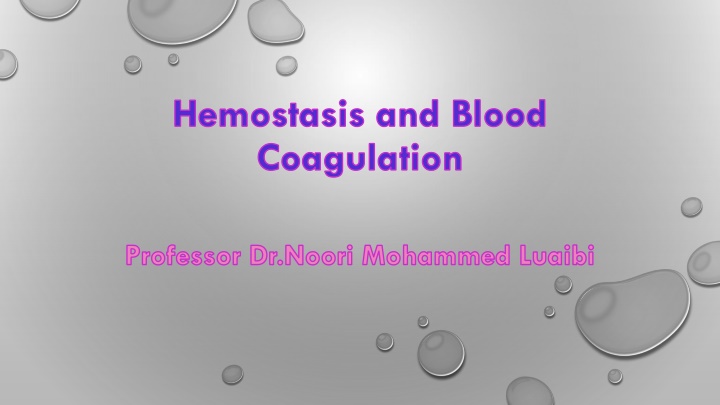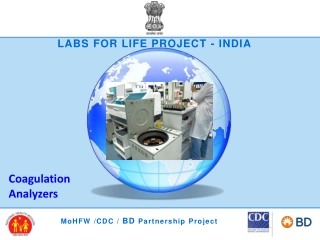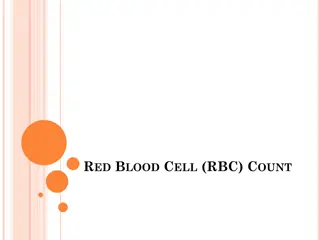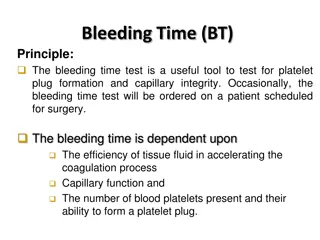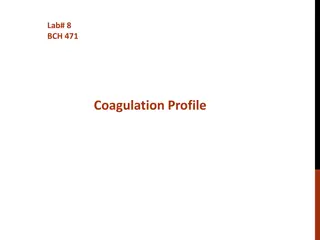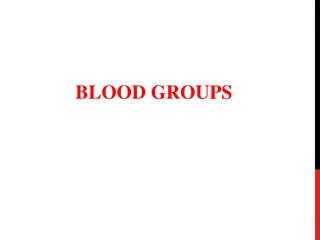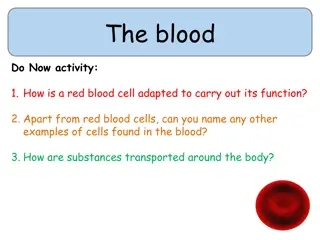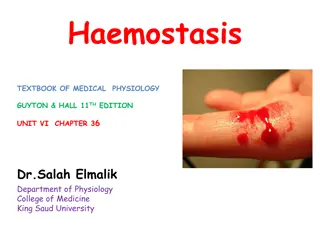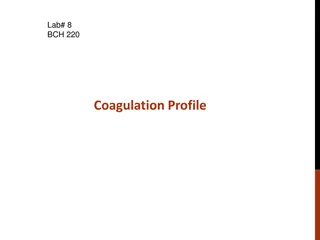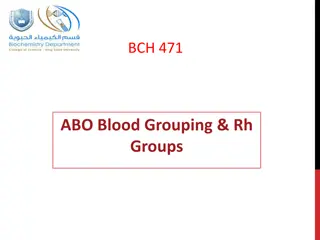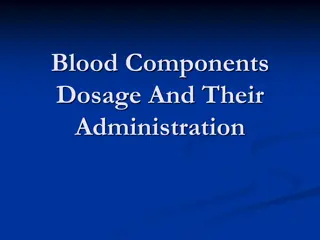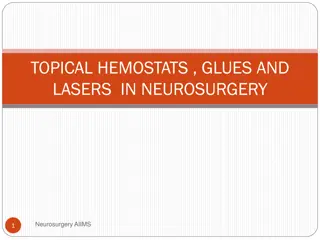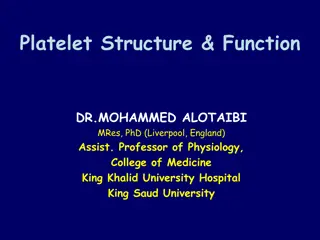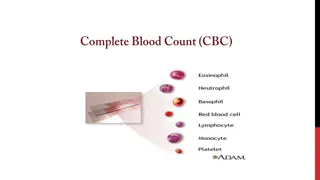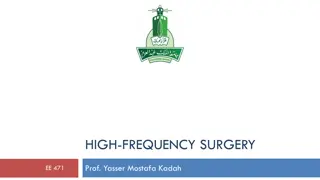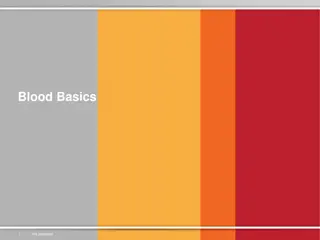Hemostasis and Blood Coagulation Mechanisms Explained
Hemostasis refers to the prevention of blood loss through vascular constriction, platelet plug formation, blood clotting, and fibrous tissue growth. Vascular constriction occurs immediately after vessel damage, initiated by myogenic spasm, autacoid factors, and nervous reflexes. Platelet plug formation occurs for small vessel cuts, with platelets playing a crucial role due to their unique characteristics. Platelets have essential functions and properties, including containing contractile proteins, enzyme systems, and glycoproteins on their surface. Understanding these mechanisms is vital for comprehending the process of hemostasis.
Download Presentation

Please find below an Image/Link to download the presentation.
The content on the website is provided AS IS for your information and personal use only. It may not be sold, licensed, or shared on other websites without obtaining consent from the author.If you encounter any issues during the download, it is possible that the publisher has removed the file from their server.
You are allowed to download the files provided on this website for personal or commercial use, subject to the condition that they are used lawfully. All files are the property of their respective owners.
The content on the website is provided AS IS for your information and personal use only. It may not be sold, licensed, or shared on other websites without obtaining consent from the author.
E N D
Presentation Transcript
Hemostasis and Blood Coagulation Professor Dr.Noori Mohammed Luaibi
HEMOSTASIS EVENTS The term hemostasis means prevention of blood loss. Whenever a vessel is severed or ruptured, hemostasis is achieved by several mechanisms: (1) vascular constriction, (2) formation of a platelet plug, (3) formation of a blood clot as a result of blood coagulation, and (4) eventual growth of fibrous tissue into the blood clot to close the hole in the vessel permanently. VASCULAR CONSTRICTION Immediately after a blood vessel has been cut or ruptured, the trauma to the vessel wall causes smooth muscle in the wall to contract; this instantaneously reduces the flow of blood from the ruptured vessel. The contraction results from (1) local myogenic spasm, (2) local autacoid factors from the traumatized tissues and blood platelets, and (3) nervous reflexes. The nervous reflexes are initiated by pain nerve impulses or other sensory impulses that originate from the traumatized vessel or nearby tissues. However, even more vasoconstriction probably results from local myogenic contraction of the blood vessels initiated by direct damage to the vascular wall. And, for the smaller vessels, the platelets are responsible for much of the vasoconstriction by releasing a vasoconstrictor substance, thromboxane A2. The more severely a vessel is traumatized, the greater the degree of vascular spasm. The spasm can last for many minutes or even hours, during which time the processes of platelet plugging and blood coagulation can take place. FORMATION OF THE PLATELET PLUG If the cut in the blood vessel is very small indeed, many very small vascular holes develop throughout the body each day the cut is often sealed by a platelet plug rather than by a blood clot. To understand this process, it is important that we first discuss the nature of platelets themselves
Physical and Chemical Characteristics of Platelets Platelets(also called thrombocytes) are minute discs 1 to 4 micrometers in diameter. They are formed in the bone marrow from megakaryocytes, which are extremely large hematopoietic cells in the marrow; the megakaryocytes fragment into the minute platelets either in the bone marrow or soon after entering the blood, especially as they squeeze through capillaries. The normal concentration of platelets in the blood is between 150,000 and 300,000 per microliter. Platelets have many functional characteristics of whole cells, even though they do not have nuclei and cannot reproduce. In their cytoplasm are (1) actin and myosin molecules, which are contractile proteins similar to those found in muscle cells, and still another contractile protein, thrombosthenin, that can cause the platelets to contract; (2) residuals of both the endoplasmic reticulum and the Golgi apparatus that synthesize various enzymes and especially store large quantities of calcium ions; (3) mitochondria and enzyme systems that are capable of forming adenosine triphosphate (ATP) and adenosine diphosphate (ADP); (4) enzyme systems that synthesize prostaglandins, which are local hormones that cause many vascular and other local tissue reactions; (5) an important protein called fibrin-stabilizing factor, which we discuss later in relation to blood coagulation; and (6) a growth factor that causes vascular endothelial cells, vascular smooth muscle cells, and fibroblasts to multiply and grow, thus causing cellular growth that eventually helps repair damaged vascular walls. On the platelet cell membrane surface is a coat of glycoproteins that repulses adherence to normal endothelium and yet causes adherence to injured areas of the vessel wall, especially to injured endothelial cells and even more so to any exposed collagen from deep within the vessel wall. In addition, the platelet membrane contains large amounts of phospholipids that activate multiple stages in the blood-clotting process, as we discuss later. Thus, the platelet is an active structure. It has a half-life in the blood of 8 to 12 days, so over several weeks its functional processes run out; it is then eliminated from the circulation mainly by the tissue macrophage system. More than one half of the platelets are removed by macrophages in the spleen, where the blood passes through a latticework of tight trabeculae.
Mechanism of the Platelet Plug Platelet repair of vascular openings is based on several important functions of the platelet. When platelets come in contact with a damaged vascular surface, especially with collagen fibers in the vascular wall, the platelets rapidly change their own characteristics drastically. They begin to swell; they assume irregular forms with numerous irradiating pseudopods protruding from their surfaces; their contractile proteins contract forcefully and cause the release of granules that contain multiple active factors; they become sticky so that they adhere to collagen in the tissues and to a protein called von Willebrand factor that leaks into the traumatized tissue from the plasma; they secrete large quantities of ADP; and their enzymes form thromboxane A2. The ADP and thromboxane in turn act on nearby platelets to activate them as well, and the stickiness of these additional platelets causes them to adhere to the original activated platelets. Therefore, at the site of a puncture in a blood vessel wall, the damaged vascular wall activates successively increasing numbers of platelets that attract more and more additional platelets, thus forming a platelet plug. This plug is loose at first, but it is usually successful in blocking blood loss if the vascular opening is small. Then, during the subsequent process of blood coagulation, fibrin threads form. These threads attach tightly to the platelets, thus constructing an unyielding plug. Importance of the Platelet Mechanism for Closing Vascular Holes. The platelet-plugging mechanism is extremely important for closing minute ruptures in very small blood vessels that occur many thousands of times daily. Indeed, multiple small holes through the endothelial cells themselves are often closed by platelets actually fusing with the endothelial cells to form additional endothelial cell membrane. Literally thousands of small hemorrhagic areas develop each day under the skin and throughout the internal tissues of a person who has few blood platelets. This phenomenon does not occur in persons with normal numbers of platelets
BLOOD COAGULATION IN THE RUPTURED VESSEL The third mechanism for hemostasis is formation of the blood clot. The clot begins to develop in 15 to 20 seconds if the trauma to the vascular wall has been severe and in 1 to 2 minutes if the trauma has been minor. Activator substances from the traumatized vascular wall, from platelets, and from blood proteins adheringto the traumatized vascular wall initiate the clotting process. The physical events of this process are shown in Figure 37-1, and Table 37-1 lists the most important of the clotting factors. Within 3 to 6 minutes after rupture of a vessel, the entire opening or broken end of the vessel is filled with clot if the vessel opening is not too large. After 20 minutes to an hour, the clot retracts, which closes the vessel still further. Platelets also play an important role in this clot retraction. Table 37-1 Clotting Factors in Blood and Their Synonyms Figure 37-1. Clotting process in a traumatized blood vessel.
FIBROUS ORGANIZATION OR DISSOLUTION OF THE BLOOD CLOT Once a blood clot has formed, it can follow one of two courses: (1) It can become invaded by fibroblasts, which subsequently form connective tissue all through the clot, or (2) it can dissolve. The usual course for a clot that forms in a small hole of a vessel wall is invasion by fibroblasts, beginning within a few hours after the clot is formed (which is promoted at least partially by growth factor secreted by platelets). This process continues to complete organization of the clot into fibrous tissue within about 1 to 2 weeks. Conversely, when excess blood has leaked into the tissues and tissue clots have occurred where they are not needed, special substances within the clot itself usually become activated. These substances function as enzymes to dissolve the clot. MECHANISM OF BLOOD COAGULATION GENERAL MECHANISM More than 50 important substances that cause or affect blood coagulation have been found in the blood and in the tissues some that promote coagulation, called procoagulants, and others that inhibit coagulation, called anticoagulants. Whether blood will coagulate depends on the balance between these two groups of substances. In the blood stream, the anticoagulants normally predominate, so the blood does not coagulate while it is circulating in the blood vessels. However, when a vessel is ruptured, procoagulants from the area of tissue damage become activated and override the anticoagulants, and then a clot does develop. Clotting takes place in three essential steps: 1. In response to rupture of the vessel or damage to the blood itself, a complex cascade of chemical reactions occurs in the blood involving more than a dozen blood coagulation factors. The net result is formation of a complex of activated substances collectively called prothrombin activator. 2. The prothrombin activator catalyzes conversion of prothrombin into thrombin. 3. The thrombin acts as an enzyme to convert fibrinogen into fibrin fibers that enmesh platelets, blood cells, and plasma to form the clot. We will first discuss the mechanism by which the blood clot itself is formed, beginning with conversion of prothrombin to thrombin, and then come back to the initiating stages in the clotting process by which prothrombin activator is formed.
CONVERSION OF PROTHROMBIN TO THROMBIN First, prothrombin activator is formed as a result of rupture of a blood vessel or as a result of damage to special substances in the blood. Second, the prothrombin activator, in the presence of sufficient amounts of ionic calcium (Ca++ ), causes conversion of prothrombin to thrombin (Figure 37-2). Third, the thrombin causes polymerization of fibrinogen molecules into fibrin fibers within another 10 to 15 seconds. Thus, the rate-limiting factor in causing blood coagulation is usually the formation of prothrombin activator and not the subsequent reactions beyond that point, because these terminal steps normally occur rapidly to form the clot. Platelets also play an important role in the conversion of prothrombin to thrombin because much of the prothrombin first attaches to prothrombin receptors on the platelets already bound to the damaged tissue. Prothrombin and Thrombin. Prothrombin is a plasma protein, an 2-globulin, having a molecular weight of 68,700. It is present in normal plasma in a concentration of about 15 mg/dl. It is an unstable protein that can split easily into smaller compounds, one of which is thrombin, which has a molecular weight of 33,700, almost exactly one half that of prothrombin. Prothrombin is formed continually by the liver, and it is continually being used throughout the body for blood clotting. If the liver fails to produce prothrombin, in a day or so prothrombin concentration in the plasma falls too low to provide normal blood coagulation. Vitamin K is required by the liver for normal activation of prothrombin, as well as a few other clotting factors. Therefore, either lack of vitamin K or the presence of liver disease that prevents normal prothrombin formation can decrease the prothrombin to such a low level that a bleeding tendency results
CONVERSION OF FIBRINOGEN TO FIBRINFORMATION OF THE CLOT Fibrinogen Formed in the Liver Is Essential for Clot Formation. Fibrinogen is a high-molecular-weight protein (molecular weight = 340,000) that occurs in the plasma in quantities of 100 to 700 mg/dl. Fibrinogen is formed in the liver, and liver disease can decrease the concentration of circulating fibrinogen, as it does the concentration of prothrombin, pointed out earlier. Because of its large molecular size, little fibrinogen normally leaks from the blood vessels into the interstitial fluids, and because fibrinogen is one of the essential factors in the coagulation process, interstitial fluids ordinarily do not coagulate. Yet, when the permeability of the capillaries becomes pathologically increased, fibrinogen does leak into the tissue fluids in sufficient quantities to allow clotting of these fluids in much the same way that plasma and whole blood can clot. Action of Thrombin on Fibrinogen to Form Fibrin. Thrombin is a protein enzyme with weak proteolytic capabilities. It acts on fibrinogen to remove four low-molecular- weight peptides from each molecule of fibrinogen, forming one molecule of fibrin monomer that has the automatic capability to polymerize with other fibrin monomer molecules to form fibrin fibers. Therefore, many fibrin monomer molecules polymerize within seconds into long fibrin fibers that constitute the reticulum of the blood clot. In the early stages of polymerization, the fibrin monomer molecules are held together by weak noncovalent hydrogen bonding, and the newly forming fibers are not cross-linked with one another; therefore, the resultant clot is weak and can be broken apart with ease. However, another process occurs during the next few minutes that greatly strengthens the fibrin reticulum. This process involves a substance called fibrin-stabilizing factor that is present in small amounts in normal plasma globulins but is also released from platelets entrapped in the clot.
Before fibrin-stabilizing factor can have an effect on the fibrin fibers, it must be activated. The same thrombin that causes fibrin formation also activates the fibrinstabilizing factor. This activated substance then operates as an enzyme to cause covalent bonds between more and more of the fibrin monomer molecules, as well as multiple cross-linkages between adjacent fibrin fibers, thus adding tremendously to the three-dimensional strength of the fibrin meshwork. Blood Clot. The clot is composed of a meshwork of fibrin fibers running in all directions and entrapping blood cells, platelets, and plasma. The fibrin fibers also adhere to damaged surfaces of blood vessels; therefore, the blood clot becomes adherent to any vascular opening and thereby prevents further blood loss. Clot Retraction and Expression of Serum. Within a few minutes after a clot is formed, it begins to contract and usually expresses most of the fluid from the clot within 20 to 60 minutes. The fluid expressed is called serum because all its fibrinogen and most of the other clotting factors have been removed; in this way, serum differs from plasma. Serum cannot clot because it lacks these factors. Platelets are necessary for clot retraction to occur. Therefore, failure of clot retraction is an indication that the number of platelets in the circulating blood might be low. Electron micrographs of platelets in blood clots show that they become attached to the fibrin fibers in such a way that they actually bond different fibers together. Furthermore, platelets entrapped in the clot continue to release procoagulant substances, one of the most important of which is fibrin-stabilizing factor, which causes more and more cross- linking bonds between adjacent fibrin fibers. In addition, the platelets contribute directly to clot contraction by activating platelet thrombosthenin, actin, and myosin molecules, which are all contractile proteins in the platelets and cause strong contraction of the platelet spicules attached to the fibrin. This action also helps compress the fibrin meshwork into a smaller mass. The contraction is activated and accelerated by thrombin, as well as by calcium ions released from calcium stores in the mitochondria, endoplasmic reticulum, and Golgi apparatus of the platelets. As the clot retracts, the edges of the broken blood vessel are pulled together, thus contributing still further to hemostasis.
POSITIVE FEEDBACK OF CLOT FORMATION Once a blood clot has started to develop, it normally extends within minutes into the surrounding blood that is, the clot initiates a positive feedback to promote more clotting. One of the most important causes of this clot promotion is that the proteolytic action of thrombin allows it to act on many of the other blood-clotting factors in addition to fibrinogen. For instance, thrombin has a direct proteolytic effect on prothrombin, tending to convert this into still more thrombin, and it acts on some of the blood-clotting factors responsible for formation of prothrombin activator. (These effects, discussed in subsequent paragraphs, include acceleration of the actions of Factors VIII, IX, X, XI, and XII and aggregation of platelets.) Once a critical amount of thrombin is formed, a positive feedback develops that causes still more blood clotting and more and more thrombin to be formed; thus, the blood clot continues to grow until blood leakage ceases. INITIATION OF COAGULATION: FORMATION OF PROTHROMBIN ACTIVATOR Now that we have discussed the clotting process, we turn to the more complex mechanisms that initiate clotting in the first place. These mechanisms are set into play by (1) trauma to the vascular wall and adjacent tissues, (2) trauma to the blood, or (3) contact of the blood with damaged endothelial cells or with collagen and other tissue elements outside the blood vessel. In each instance, this leads to the formation of prothrombin activator, which then causes prothrombin conversion to thrombin and all the subsequent clotting steps. Prothrombin activator is generally considered to be formed in two ways, although, in reality, the two ways interact constantly with each other: (1) by the extrinsic pathway that begins with trauma to the vascular wall and surrounding tissues and (2) by the intrinsic pathway that begins in the blood. In both the extrinsic and the intrinsic pathways, a series of different plasma proteins called blood-clotting factors plays a major role. Most of these proteins are inactive forms of proteolytic enzymes. When converted to the active forms, their enzymatic actions cause the successive, cascading reactions of the clotting process. Most of the clotting factors, which are listed in Table 37-1, are designated by Roman numerals. To indicate the activated form of the factor, a small letter a is added after the Roman numeral, such as Factor VIIIa to indicate the activated state of Factor VIII.
Extrinsic Pathway for Initiating Clotting The extrinsic pathway for initiating the formation of prothrombin activator begins with a traumatized vascular wall or traumatized extravascular tissues that come in contact with the blood. This condition leads to the following steps, as shown in Figure 37-3: 1. Release of tissue factor. Traumatized tissue releases a complex of several factors called tissue factor or tissue thromboplastin. This factor is composed especially of phospholipids from the membranes of the tissue plus a lipoprotein complex that functions mainly as a proteolytic enzyme. 2. Activation of Factor X role of Factor VII and tissue factor. The lipoprotein complex of tissue factor further complexes with blood coagulation Factor VII and, in the presence of calcium ions, acts enzymatically on Factor X to form activated Factor X (Xa). 3. Effect of Xa to form prothrombin activator role of Factor V. The activated Factor X combines immediately with tissue phospholipids that are part of tissue factors or with additional phospholipids released from platelets, as well as with Factor V, to form the complex called prothrombin activator. Within a few seconds, in the presence of Ca++, rothrombin is split to form thrombin, and the clotting process proceeds as already explained. At first, the Factor V in the prothrombin activator complex is inactive, but once clotting begins and thrombin begins to form, the proteolytic action of thrombin activates Factor V. This activation then becomes an additional strong accelerator of prothrombin activation. Thus, in the final prothrombin activator complex, activated Factor X is the actual protease that causes splitting of prothrombin to form thrombin; activated Factor V greatly accelerates this protease activity, and platelet phospholipids act as a vehicle that further accelerates the process. Note especially the positive feedback effect of thrombin, acting through Factor V, to accelerate the entire process once it begins.
Figure 37-3. Extrinsic pathway for initiating blood clotting. Figure 37-4. Intrinsic pathway for initiating blood clotting. Intrinsic Pathway for Initiating Clotting The second mechanism for initiating formation of prothrombin activator, and therefore for initiating clotting, begins with trauma to the blood or exposure of the blood to collagen from a traumatized blood vessel wall. Then the process continues through the series of cascading reactions shown in Figure 37-4. 1. Blood trauma causes (1) activation of Factor XII and (2) release of platelet phospholipids. Trauma to the blood or exposure of the blood to vascular wall collagen alters two important clotting factors in the blood: Factor XII and the platelets. When Factor XII is disturbed, such as by coming into contact with collagen or with a wettable surface such as glass, it takes on a new molecular configuration that converts it into a proteolytic enzyme called activated Factor XII. Simultaneously, the blood trauma also damages the platelets because of adherence to either collagen or a wettable surface (or by damage in other ways), and this releases platelet phospholipids that contain the lipoprotein called platelet factor 3, which also plays a role in subsequent clotting reactions.
2. Activation of Factor XI. The activated Factor XII acts enzymatically on Factor XI to activate this factor as well, which is the second step in the intrinsic pathway. This reaction also requires highmolecular-weight kininogen and is accelerated by prekallikrein. 3. Activation of Factor IX by activated Factor XI. The activated Factor XI then acts enzymatically on Factor IX to activate this factor as well. 4. Activation of Factor X role of Factor VIII. The activated Factor IX, acting in concert with activated Factor VIII and with the platelet phospholipids and Factor III from the traumatized platelets, activates Factor X. It is clear that when either Factor VIII or platelets are in short supply, this step is deficient. Factor VIII is the factor that is missing in a person who has classic hemophilia, for which reason it is called antihemophilic factor. Platelets are the clotting factor that is lacking in the bleeding disease called thrombocytopenia. 5. Action of activated Factor X to form prothrombin activator role of Factor V. This step in the intrinsic pathway is the same as the last step in the extrinsic pathway. That is, activated Factor X combines with Factor V and platelet or tissue phospholipids to form the complex called prothrombin activator. The prothrombin activator in turn initiates within seconds the cleavage of prothrombin to form thrombin, thereby setting into motion the final clotting process, as described earlier. Role of Calcium Ions in the Intrinsic and Extrinsic Pathways Except for the first two steps in the intrinsic pathway, calcium ions are required for promotion or acceleration of all the blood- clotting reactions. Therefore, in the absence of calcium ions, blood clotting by either pathway does not occur. In the living body, the calcium ion concentration seldom falls low enough to significantly affect the kinetics of blood clotting. However, when blood is removed from a person, it can be prevented from clotting by reducing the calcium ion concentration below the threshold level for clotting, either by deionizing the calcium by causing it to react with substances such as citrate ion or by precipitating the calcium with substances such as oxalate ion.
Interaction between the Extrinsic and Intrinsic PathwaysSummary of Blood-Clotting Initiation It is clear from the schemas of the intrinsic and extrinsic systems that after blood vessels rupture, clotting occurs by both pathways simultaneously. Tissue factor initiates the extrinsic pathway, whereas contact of Factor XII and platelets with collagen in the vascular wall initiates the intrinsic pathway. An especially important difference between the extrinsic and intrinsic pathways is that the extrinsic pathway can be explosive; once initiated, its speed of completion to the final clot is limited only by the amount of tissue factor released from the traumatized tissues and by the quantities of Factors X, VII, and V in the blood. With severe tissue trauma, clotting can occur in as little as 15 seconds. The intrinsic pathway is much slower to proceed, usually requiring 1 to 6 minutes to cause clotting. Intravascular Anticoagulants Prevent Blood Clotting in the Normal Vascular System Endothelial Surface Factors. Probably the most important factors for preventing clotting in the normal vascular system are (1) the smoothness of the endothelial cell surface, which prevents contact activation of the intrinsic clotting system; (2) a layer of glycocalyx on the endothelium (glycocalyx is a mucopolysaccharide adsorbed to the surfaces of the endothelial cells), which repels clotting factors and platelets, thereby preventing activation of clotting; and (3) a protein bound with the endothelial membrane, thrombomodulin, which binds thrombin. Not only does the binding of thrombin with thrombomodulin slow the clotting process by removing thrombin, but the thrombomodulin-thrombin complex also activates a plasma protein, protein C, that acts as an anticoagulant by inactivating activated Factors V and VIII. When the endothelial wall is damaged, its smoothness and its glycocalyx-thrombomodulin layer are lost, which activates both Factor XII and the platelets, thus setting off the intrinsic pathway of clotting. If Factor XII and platelets come in contact with the subendothelial collagen, the activation is even more powerful.
Antithrombin Action of Fibrin and Antithrombin III. Among the most important anticoagulants in the blood are those that remove thrombin from the blood. The most powerful of these are (1) the fibrin fibers that are formed during the process of clotting and (2) an -globulin called antithrombin III or antithrombin- heparin cofactor. While a clot is forming, about 85 to 90 percent of the thrombin formed from the prothrombin becomes adsorbed to the fibrin fibers as they develop. This adsorption helps prevent the spread of thrombin into the remaining blood and, therefore, prevents excessive spread of the clot. The thrombin that does not adsorb to the fibrin fibers soon combines with antithrombin III, which further blocks the effect of the thrombin on the fibrinogen and then also inactivates the thrombin itself during the next 12 to 20 minutes. Heparin. Heparin is another powerful anticoagulant, but because its concentration in the blood is normally low, it has significant anticoagulant effects only under special physiological conditions. However, heparin is used widely as a pharmacological agent in medical practice in much higher concentrations to prevent intravascular clotting. The heparin molecule is a highly negatively charged conjugated polysaccharide. By itself, it has little or no anticoagulant properties, but when it combines with antithrombin III, the effectiveness of antithrombin III for removing thrombin increases by a hundredfold to a thousandfold, and thus it acts as an anticoagulant. Therefore, in the presence of excess heparin, removal of free thrombin from the circulating blood by antithrombin III is almost instantaneous. The complex of heparin and antithrombin III removes several other activated coagulation factors in addition to thrombin, further enhancing the effectiveness of anticoagulation. The others include activated Factors XII, XI, X, and IX. Heparin is produced by many different cells of the body, but the largest quantities are formed by the basophilic mast cells located in the pericapillary connective tissue throughout the body. These cells continually secrete small quantities of heparin that diffuse into the circulatory system. The basophil cells of the blood, which are functionally almost identical to the mast cells, release small quantities of heparin into the plasma. Mast cells are abundant in tissue surrounding the capillaries of the lungs and, to a lesser extent, capillaries of the liver. It is easy to understand why large quantities of heparin might be needed in these areas because the capillaries of the lungs and liver receive many embolic clots formed in slowly flowing venous blood; sufficient formation of heparin prevents further growth of the clots.
PLASMIN CAUSES LYSIS OF BLOOD CLOTS The plasma proteins contain a euglobulin called plasminogen (or profibrinolysin) that, when activated, becomes a substance called plasmin (or fibrinolysin). Plasmin is a proteolytic enzyme that resembles trypsin, the most important proteolytic digestive enzyme of pancreatic secretion. Plasmin digests fibrin fibers and some other protein coagulants such as fibrinogen, Factor V, Factor VIII, prothrombin, and Factor XII. Therefore, whenever plasmin is formed, it can cause lysis of a clot by destroying many of the clotting factors, thereby sometimes even causing hypocoagulability of the blood. Activation of Plasminogen to Form Plasmin, Then Lysis of Clots. When a clot is formed, a large amount of plasminogen is trapped in the clot along with other plasma proteins. This will not become plasmin or cause lysis of the clot until it is activated. The injured tissues and vascular endothelium very slowly release a powerful activator called tissue plasminogen activator (t-PA); a few days later, after the clot has stopped the bleeding, t-PA eventually converts plasminogen to plasmin, which in turn removes the remaining unnecessary blood clot. In fact, many small blood vessels in which blood flow has been blocked by clots are reopened by this mechanism. Thus, an especially important function of the plasmin system is to remove minute clots from millions of tiny peripheral vessels that eventually would become occluded were there no way to clear them. CONDITIONS THAT CAUSE EXCESSIVE BLEEDING IN HUMANS Excessive bleeding can result from a deficiency of any one of the many blood-clotting factors. Three particular types of bleeding tendencies that have been studied to the greatest extent are discussed here: bleeding caused by (1) vitamin K deficiency, (2) hemophilia, and (3) thrombocytopenia (platelet deficiency).
DECREASED PROTHROMBIN, FACTOR VII, FACTOR IX, AND FACTOR X CAUSED BY VITAMIN K DEFICIENCY With few exceptions, almost all the blood-clotting factors are formed by the liver. Therefore, diseases of the liver such as hepatitis, cirrhosis, and acute yellow atrophy (i.e., degeneration of the liver caused by toxins, infections, or other agents) can sometimes depress the clotting system so greatly that the patient experiences the development of a severe tendency to bleed. Another cause of depressed formation of clotting factors by the liver is vitamin K deficiency. Vitamin K is an essential factor to a liver carboxylase that adds a carboxyl group to glutamic acid residues on five of the important clotting factors: prothrombin, Factor VII, Factor IX, Factor X, and protein C. Upon adding the carboxyl group to glutamic acid residues on the immature clotting factors, vitamin K is oxidized and becomes inactive. Another enzyme, vitamin K epoxide reductase complex 1 (VKOR c1), reduces vitamin K back to its active form. In the absence of active vitamin K, subsequent insufficiency of these coagulation factors in the blood can lead to serious bleeding tendencies. Vitamin K is continually synthesized in the intestinal tract by bacteria, so vitamin K deficiencyoccurs in healthy persons as a result of the absence of vitamin K from the diet (except in neonates before they establish their intestinal bacterial flora). However, in persons with gastrointestinal disease, vitamin K deficiency often occurs as a result of poor absorption of fats from the gastrointestinal tract because vitamin K is fat soluble and is ordinarily absorbed into the blood along with the fats. One of the most prevalent causes of vitamin K deficiency is failure of the liver to secrete bile into the gastrointestinal tract (which occurs either as a result of obstruction of the bile ducts or as a result of liver disease). Lack of bile prevents adequate fat digestion and absorption and, therefore, depresses vitamin K absorption as well. Thus, liver disease often causes decreased production of prothrombin and some other clotting factors both because of poor vitamin K absorption and because of the diseased liver cells. As a result, vitamin K is injected into surgical patients with liver disease or with obstructed bile ducts before the surgical procedure is performed. Ordinarily, if vitamin K is given to a deficient patient 4 to 8 hours before the operation and the liver parenchymal cells are at least one-half normal in function, sufficient clotting factors will be produced to prevent excessive bleeding during the operation.
HEMOPHILIA Hemophilia is a bleeding disease that occurs almost exclusively in males. In 85 percent of cases, it is caused by an abnormality or deficiency of Factor VIII; this type of hemophilia is called hemophilia A or classic hemophilia. About 1 of every 10,000 males in the United States has classic hemophilia. In the other 15 percent of patients with hemophilia, the bleeding tendency is caused by deficiency of Factor IX. Both of these factors are transmitted genetically by way of the female chromosome. Therefore, a woman will almost never have hemophilia because at least one of her two X chromosomes will have the appropriate genes. If one of her X chromosomes is deficient, she will be a hemophilia carrier, transmitting the disease to half of her male offspring and transmitting the carrier state to half of her female offspring. The bleeding trait in hemophilia can have various degrees of severity, depending on the genetic deficiency. Bleeding usually does not occur except after trauma, but in some patients, the degree of trauma required to cause severe and prolonged bleeding may be so mild that it is hardly noticeable. For instance, bleeding can often last for days after extraction of a tooth. Factor VIII has two active components, a large component with a molecular weight in the millions and a smaller component with a molecular weight of about 230,000. The smaller component is most important in the intrinsic pathway for clotting, and it is deficiency of this part of Factor VIII that causes classic hemophilia. Another bleeding disease with somewhat different characteristics, called von Willebrand disease, results from loss of the large component. When a person with classic hemophilia experiences severe prolonged bleeding, almost the only therapy that is truly effective is injection of purified Factor VIII. The cost of Factor VIII is high because it is gathered from human blood and only in extremely small quantities. However, increasing production and use of recombinant Factor VIII is making this treatment available to more patients with classic hemophilia
THROMBOCYTOPENIA Thrombocytopenia means the presence of very low numbers of platelets in the circulating blood. People with thrombocytopenia have a tendency to bleed, as do hemophiliacs, except that the bleeding is usually from many small venules or capillaries, rather than from larger vessels, as in hemophilia. As a result, small punctate hemorrhages occur throughout all the body tissues. The skin of such a person displays many small, purplish blotches, giving the disease the name thrombocytopenic purpura. As stated earlier, platelets are especially important for repair of minute breaks in capillaries and other small vessels. Ordinarily, bleeding will not occur until the number of platelets in the blood falls below 50,000/ l, rather than the normal 150,000 to 300,000. Levels as low as 10,000/ l are frequently lethal. Even without making specific platelet counts in the blood, sometimes one can suspect the existence of thrombocytopenia if the person s blood clot fails to retract. As pointed out earlier, clot retraction is normally dependent on release of multiple coagulation factors from the large numbers of platelets entrapped in the fibrin mesh of the clot. Most people with thrombocytopenia have the disease known as idiopathic thrombocytopenia, which means thrombocytopenia of unknown cause. In most of these people, it has been discovered that, for unknown reasons, specific antibodies have formed and react against the platelets to destroy them. Relief from bleeding for 1 to 4 days can often be effected in a patient with thrombocytopenia by giving fresh whole blood transfusions that contain large numbers of platelets. Also, splenectomy is often helpful, sometimes effecting almost complete cure because the spleen normally removes large numbers of platelets from the blood. THROMBOEMBOLIC CONDITIONS Thrombi and Emboli. An abnormal clot that develops in a blood vessel is called a thrombus. Once a clot has developed, continued flow of blood past the clot is likely to break it away from its attachment and cause the clot to flow with the blood; such freely flowing clots are known as emboli. Also, emboli that originate in large arteries or in the left side of the heart can flow peripherally and plug arteries or arterioles in the brain, kidneys, or elsewhere. Emboli that originate in the venous system or in the right side of the heart generally flow into the lungs to cause pulmonary arterial embolism.
Cause of Thromboembolic Conditions. The causes of thromboembolic conditions in the human being are usually twofold: (1) A roughened endothelial surface of a vessel as may be caused by arteriosclerosis, infection, or trauma is likely to initiate the clotting process, and (2) blood often clots when it flows very slowly through blood vessels, where small quantities of thrombin and other procoagulants are always being formed. Use of t-PA in Treating Intravascular Clots. Genetically engineered t-PA is available. When delivered through a catheter to an area with a thrombus, it is effective in activating plasminogen to plasmin, which in turn can dissolve some intravascular clots. For instance, if used within the first hour or so after thrombotic occlusion of a coronary artery, the heart is often spared serious damage. FEMORAL VENOUS THROMBOSIS AND MASSIVE PULMONARY EMBOLISM Because clotting almost always occurs when blood flow is blocked for many hours in any vessel of the body, the immobility of patients confined to bed plus the practice of propping the knees with pillows often causes intravascular clotting because of blood stasis in one or more of the leg veins for hours at a time. Then the clot grows, mainly in the direction of the slowly moving venous blood, sometimes growing the entire length of the leg veins and occasionally even up into the common iliac vein and inferior vena cava. Then, about 1 out of every 10 times, a large part of the clot disengages from its attachments to the vessel wall and flows freely with the venous blood through the right side of the heart and into the pulmonary arteries to cause massive blockage of the pulmonary arteries, called massive pulmonary embolism. If the clot is large enough to occlude both pulmonary arteries at the same time, immediate death ensues. If only one pulmonary artery is blocked, death may not occur, or the embolism may lead to death a few hours to several days later because of further growth of the clot within the pulmonary vessels. However, again, t-PA therapy can be a lifesaver.
DISSEMINATED INTRAVASCULAR COAGULATION Occasionally the clotting mechanism becomes activated in widespread areas of the circulation, giving rise to the condition called disseminated intravascular coagulation. This condition often results from the presence of large amounts of traumatized or dying tissue in the body that releases great quantities of tissue factor into the blood. Frequently, the clots are small but numerous, and they plug a large share of the small peripheral blood vessels. This process occurs especially in patients with widespread septicemia, in which either circulating bacteria or bacterial toxins especially endotoxins activate the clotting mechanisms. Plugging of small peripheral vessels greatly diminishes delivery of oxygen and other nutrients to the tissues, a situation that leads to or exacerbates circulatory shock. It is partly for this reason that septicemic shock is lethal in 85 percent or more of patients. A peculiar effect of disseminated intravascular coagulation is that the patient on occasion begins to bleed. The reason for this bleeding is that so many of the clotting factors are removed by the widespread clotting that too few procoagulants remain to allow normal hemostasis of the remaining blood. ANTICOAGULANTS FOR CLINICAL USE In some thromboembolic conditions, it is desirable to delay the coagulation process. Various anticoagulants have been developed for this purpose. The ones most useful clinically are heparin and the coumarins. HEPARIN AS AN INTRAVENOUS ANTICOAGULANT Commercial heparin is extracted from several different animal tissues and prepared in almost pure form. Injection of relatively small quantities, about 0.5 to 1 mg/kg of body weight, causes the blood-clotting time to increase from a normal of about 6 minutes to 30 or more minutes. Furthermore, this change in clotting time occurs instantaneously, thereby immediately preventing or slowing further development of a thromboembolic condition. The action of heparin lasts about 1.5 to 4 hours. The injected heparin is destroyed by an enzyme in the blood known as heparinase.
COUMARINS AS ANTICOAGULANTS When a coumarin, such as warfarin, is given to a patient, the amounts of active prothrombin and Factors VII, IX, and X, all formed by the liver, begin to fall. Warfarin causes this effect by inhibiting the enzyme VKOR c1. As discussed previously, this enzyme converts the inactive, oxidized form of vitamin K to its active, reduced form. By inhibiting VKOR c1, warfarin decreases the available active form of vitamin K in the tissues. When this decrease occurs, the coagulation factors are no longer carboxylated and are biologically inactive. Over several days the body stores of the active coagulation factors degrade and are replaced by inactive factors. Although the coagulation factors continue to be produced, they have greatly decreased coagulant activity. After administration of an effective dose of warfarin, the coagulant activity of the blood decreases to about 50percent of normal by the end of 12 hours and to about 20 percent of normal by the end of 24 hours. In other words, the coagulation process is not blocked immediately but must await the degradation of the active prothrombin and the other affected coagulation factors already present in the plasma. Normal coagulation usually returns 1 to 3 days after discontinuing coumarin therapy. PREVENTION OF BLOOD COAGULATION OUTSIDE THE BODY Although blood removed from the body and held in a glass test tube normally clots in about 6 minutes, blood collected in siliconized containers often does not clot for 1 hour or more. The reason for this delay is that preparing the surfaces of the containers with silicone prevents contact activation of platelets and Factor XII, the two principal factors that initiate the intrinsic clotting mechanism. Conversely, untreated glass containers allow contact activation of the platelets and Factor XII, with rapid development of clots. Heparin can be used for preventing coagulation of blood outside the body, as well as in the body. Heparin is especially used in surgical procedures in which the blood must be passed through a heart-lung machine or artificial kidney machine and then back into the person. Various substances that decrease the concentration of calcium ions in the blood can also be used for preventing blood coagulation outside the body. For instance, a soluble oxalate compound mixed in a very small quantity with a sample of blood causes precipitation of calcium oxalate from the plasma and thereby decreases the ionic calcium level so much that blood coagulation is blocked.
Any substance that deionizes the blood calcium will prevent coagulation. The negatively charged citrate ion is especially valuable for this purpose, mixed with blood usually in the form of sodium, ammonium, or potassium citrate. The citrate ion combines with calcium in the blood to cause an un-ionized calcium compound, and the lack of ionic calcium prevents coagulation. Citrate anticoagulants have an important advantage over the oxalate anticoagulants because oxalate is toxic to the body, whereas moderate quantities of citrate can be injected intravenously. After injection, the citrate ion is removed from the blood within a few minutes by the liver and is polymerized into glucose or metabolized directly for energy. Consequently, 500 milliliters of blood that has been rendered incoagulable by citrate can ordinarily be transfused into a recipient within a few minutes without dire consequences. However, if the liver is damaged or if large quantities of citrated blood or plasma are given too rapidly (within fractions of a minute), the citrate ion may not be removed quickly enough and the citrate can, under these conditions, greatly depress the level of calcium ion in the blood, which can result in tetany and convulsive death. BLOOD COAGULATION TESTS BLEEDING TIME When a sharp-pointed knife is used to pierce the tip of the finger or lobe of the ear, bleeding ordinarily lasts for 1 to 6 minutes. The time depends largely on the depth of the wound and the degree of hyperemia in the finger or ear lobe at the time of the test. Lack of any one of several of the clotting factors can prolong the bleeding time, but it is especially prolonged by lack of platelets. CLOTTING TIME Many methods have been devised for determining blood clotting times. The one most widely used is to collect blood in a chemically clean glass test tube and then to tip the tube back and forth about every 30 seconds until the blood has clotted. By this method, the normal clotting time is 6 to 10 minutes. Procedures using multiple test tubes have also been devised for determining clotting time more accurately. Unfortunately, the clotting time varies widely, depending on the method used for measuring it, so it is no longer used in many clinics. Instead, measurements of the clotting factors themselves are made, using sophisticated chemical procedures.
PROTHROMBIN TIME AND INTERNATIONAL NORMALIZED RATIO Prothrombin time gives an indication of the concentration of prothrombin in the blood. Figure 37-5 shows the relation of prothrombin concentration to prothrombin time. The method for determining prothrombin time is the following. Blood removed from the patient is immediately oxalated so that none of the prothrombin can change into thrombin. Then, a large excess of calcium ion and tissue factor is quickly mixed with the oxalated blood. The excess calcium nullifies the effect of the oxalate, and the tissue factor activates the prothrombin-to-thrombin reaction by means of the extrinsic clotting pathway. The time required for coagulation to take place is known as the prothrombin time. The shortness of the time is determined mainly by prothrombin concentration. The normal prothrombin time is about 12 seconds. In each laboratory, a curve relating prothrombin concentration to prothrombin time, such as that shown in Figure 37-5, is drawn for the method used so that the prothrombin in the blood can be quantified. The results obtained for prothrombin time may vary considerably even in the same individual if there are differences in activity of the tissue factor and the analytical system used to perform the test. Tissue factor is isolated from human tissues, such as placental tissue, and different batches may have different activity. The international normalized ratio (INR) was devised as a way to standardize measurements of prothrombin time. For each batch of tissue factor, the manufacturer assigns an international sensitivity index (ISI), which indicates the activity of the tissue factor with a standardized sample. The ISI usually varies between 1.0 and 2.0. The INR is the ratio of the person s prothrombin time (PT) to a normal control sample raised to the power of the ISI:
The normal range for INR in a healthy person is 0.9 to 1.3. A high INR level (e.g., 4 or 5) indicates a high risk of bleeding, whereas a low INR (e.g., 0.5) suggests that there is a chance of having a clot. Patients undergoing warfarin therapy usually have an INR of 2.0 to 3.0. Tests similar to that for prothrombin time and INR have been devised to determine the quantities of other blood clotting factors. In each of these tests, excesses of calcium ions and all the other factors besides the one being tested are added to oxalated blood all at once. Then the time required for coagulation is determined in the same manner as for prothrombin time. If the factor being tested is deficient, the coagulation time is prolonged. The time itself can then be used to quantitate the concentration of the factor.
